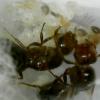So I was randomly watching bee keeping videos and one of them made a passing mention of fogging hives with mineral oil to kill parasitic mites on bees. Thought I'd bring it up since I know mites are a big concern for a lot of folks. It seems like the mineral oil suffocates the mites but doesn't harm the bees. The mineral oil is food safe and shouldn't kill anything chemically, from what I've seen. Whether or not it would suffocate ants or not could be worth looking into. There seem to be other methods including dusting with powdered sugar. Obviously it may be more effective against specific species of mites than others and could potentially be harmful to ants, especially smaller ones I imagine. Could be worth looking into for anyone wanting to do more than cursory research.
http://www.apiservic...mineral_oil.htm















